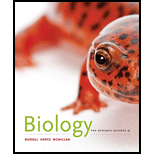
Concept explainers
The “father” of taxonomy is:
Charles Darwin.
Charles Lyell.
Alfred Wallace.
Carolus Linnaeus.
Jean Baptise de Lamarck.
Introduction:
Taxonomy is a branch of biology for naming and classifying organisms into various groups for their easy identification. It involves two important systems, namely the hierarchical classification system and the binomial nomenclature system.
Answer to Problem 1TYK
Correct answer:
Carolus Linnaeus is called as father of taxonomy.
Explanation of Solution
Justification/ Explanation for the correct answer:
Option (d) is, ‘Carolus Linnaeus’. He was a Swedish botanist. He is known as father of taxonomy and developed the science of taxonomy in 1700s. Hence, option (d) is correct.
Explanation for the incorrect answers:
Option (a) is, ‘Charles Darwin’. He was a famous geologist and a pioneer of the book called “Origin of species: By means of Natural Selection”. So, it is an incorrect option.
Option (b) is, ‘Charles Lyell’. He was a geologist and wrote a famous book called “Principles of Geology”. So, it is an incorrect option.
Option (c) is, ‘Alfred Wallace.’ He was a young naturalist, worked in Asian tropics. He had wrote about how species change through time by describing the mechanism of biological evolution. So, it is an incorrect option.
Option (e) is, ‘Jean Baptiste de Lamarck’. He was a French naturalist. He developed the theory of biological evolution and known for his work on the theory of inheritance of acquired characteristics. So, it is an incorrect option.
Hence, options (a), (b), (c), and (e) are incorrect.
It can be concluded that the father of taxonomy is Carolus Linnaeus, who has made the classification and naming of organisms easier and simpler. He developed the science of taxonomy.
Want to see more full solutions like this?
Chapter 20 Solutions
Biology: The Dynamic Science (MindTap Course List)
- For short answer questions, write your answers on the line provided. To the right is the mRNA codon table to use as needed throughout the exam. First letter U บบบ U CA UUCPhe UUA UCU Phe UCC UUG Leu CUU UAU. G U UAC TV UGCys UAA Stop UGA Stop A UAG Stop UGG Trp Ser UCA UCG CCU] 0 CUC CUA CCC CAC CAU His CGU CGC Leu Pro CCA CAA Gin CGA Arg CUG CCG CAG CGG AUU ACU AAU T AUC lle A 1 ACC Thr AUA ACA AUG Mot ACG AGG Arg GUU GCU GUC GCC G Val Ala GAC Asp GGU GGC GUA GUG GCA GCG GAA GGA Gly Glu GAGJ GGG AACASH AGU Ser AAA1 AAG Lys GAU AGA CAL CALUCAO CAO G Third letter 1. (+7) Use the table below to answer the questions; use the codon table above to assist you. The promoter sequence of DNA is on the LEFT. You do not need to fill in the entire table. Assume we are in the middle of a gene sequence (no need to find a start codon). DNA 1 DNA 2 mRNA tRNA Polypeptide C Val G C. T A C a. On which strand of DNA is the template strand (DNA 1 or 2)?_ b. On which side of the mRNA is the 5' end (left or…arrow_forward3. (6 pts) Fill in the boxes according to the directions on the right. Structure R-C R-COOH OH R-OH i R-CO-R' R R-PO4 R-CH3 C. 0 R' R-O-P-OH 1 OH H R-C-H R-N' I- H H R-NH₂ \H Name Propertiesarrow_forward4. (6 pts) Use the molecule below to answer these questions and identify the side chains and ends. Please use tidy boxes to indicate parts and write the letter labels within that box. a. How many monomer subunits are shown? b. Box a Polar but non-ionizable side chain and label P c. Box a Basic Polar side chain and label BP d. Box the carboxyl group at the end of the polypeptide and label with letter C (C-terminus) H H OHHO H H 0 HHO H-N-CC-N-C-C N-C-C-N-GC-OH I H-C-H CH2 CH2 CH2 H3C-C+H CH2 CH2 OH CH CH₂ C=O OH CH2 NH2arrow_forward
- please draw in what the steps are given. Thank you!arrow_forwardplease draw in and fill out the empty slots from image below. thank you!arrow_forwardThere is a species of eagle, which lives in a tropical forest in Brazil. The alula pattern of its wings is determined by a single autosomal gene with four alleles that exhibit an unknown hierarchy of dominance. Genetic testing shows that individuals 1-1, 11-4, 11-7, III-1, and III-4 are each homozygous. How many possible genotypes among checkered eagles in the population?arrow_forward
 Biology: The Dynamic Science (MindTap Course List)BiologyISBN:9781305389892Author:Peter J. Russell, Paul E. Hertz, Beverly McMillanPublisher:Cengage Learning
Biology: The Dynamic Science (MindTap Course List)BiologyISBN:9781305389892Author:Peter J. Russell, Paul E. Hertz, Beverly McMillanPublisher:Cengage Learning Concepts of BiologyBiologyISBN:9781938168116Author:Samantha Fowler, Rebecca Roush, James WisePublisher:OpenStax CollegeEssentials Health Info Management Principles/Prac...Health & NutritionISBN:9780357191651Author:BowiePublisher:Cengage
Concepts of BiologyBiologyISBN:9781938168116Author:Samantha Fowler, Rebecca Roush, James WisePublisher:OpenStax CollegeEssentials Health Info Management Principles/Prac...Health & NutritionISBN:9780357191651Author:BowiePublisher:Cengage Human Biology (MindTap Course List)BiologyISBN:9781305112100Author:Cecie Starr, Beverly McMillanPublisher:Cengage Learning
Human Biology (MindTap Course List)BiologyISBN:9781305112100Author:Cecie Starr, Beverly McMillanPublisher:Cengage Learning Human Heredity: Principles and Issues (MindTap Co...BiologyISBN:9781305251052Author:Michael CummingsPublisher:Cengage Learning
Human Heredity: Principles and Issues (MindTap Co...BiologyISBN:9781305251052Author:Michael CummingsPublisher:Cengage Learning





